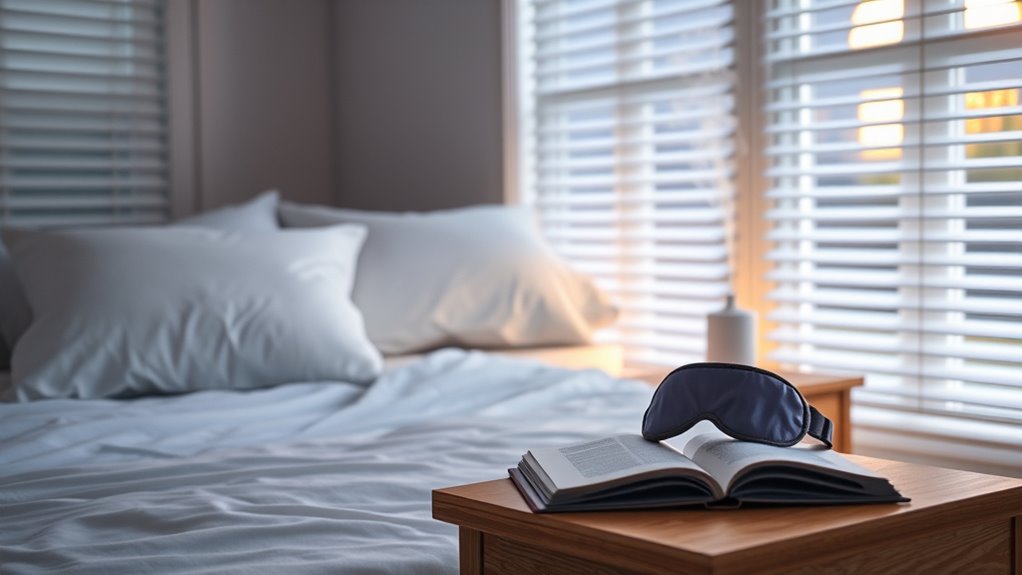To improve your sleep, create a consistent routine by going to bed and waking up at the same time daily. Make your environment dark, cool (60-67°F), and quiet using blackout curtains, eye masks, and white noise if needed. Avoid screens and stimulating activities before bed, and incorporate calming habits like reading or gentle stretches. Paying attention to these evidence-based tips will help you enjoy more restful, restorative sleep—keep exploring to discover more strategies that work for you.
Key Takeaways
- Maintain a consistent sleep schedule by going to bed and waking up at the same times daily.
- Create a sleep-friendly environment: dark, cool, quiet, and clutter-free to signal readiness for rest.
- Establish calming pre-sleep routines like reading or warm baths, and avoid screens an hour before bed.
- Manage stress through mindfulness or relaxation techniques to improve sleep quality.
- Limit stimulants like caffeine and heavy meals before bedtime to prevent sleep disruptions.

Have you ever wondered why some nights you drift off easily while others leave you tossing and turning? The answer often lies in the environment you create for sleep and the routines you follow. Your bedroom environment plays an essential role in signaling to your brain that it’s time to rest. A dark, quiet, and cool room helps your body lower its core temperature, which is vital for falling asleep. Consider blackout curtains or an eye mask to block out light, and use earplugs or white noise machines to drown out disruptive sounds. Keeping the room at a comfortable temperature, around 60-67°F (15-19°C), can make a significant difference. Furthermore, your bed should be inviting—comfortable mattress and pillows that support restful sleep. Avoid clutter and distractions in your bedroom, as a tidy space promotes relaxation and mental clarity. Additionally, incorporating sleep-friendly products such as calming essential oils or specialized sleep aids can enhance your sleep environment.
Equally important is your sleep routine, which conditions your body to recognize when it’s time to wind down. Going to bed and waking up at the same time every day helps regulate your internal clock, making it easier to fall asleep naturally. Establishing a consistent sleep schedule signals to your brain that bedtime is approaching, which can improve both sleep onset and quality. Before bed, develop a calming routine that prepares your mind and body for sleep. Activities like reading a book, taking a warm bath, or practicing gentle stretches can relax your muscles and reduce stress. Avoid screens—smartphones, tablets, and computers—at least an hour before bed because the blue light emitted suppresses melatonin, the hormone responsible for sleep.
Creating a sleep-friendly environment and sticking to a routine work together to reinforce your body’s natural sleep signals. When your bedroom environment is optimized—dim, cool, and quiet—and your sleep routine is consistent, your body learns to associate certain cues with sleep, making it easier to fall asleep quickly and stay asleep longer. Be mindful of what you do in the hour before bed; reducing caffeine intake, avoiding heavy meals, and managing stress through mindfulness or meditation can further enhance your sleep. Remember, sleep hygiene isn’t about quick fixes but building lasting habits that support your overall health and well-being. By paying attention to your environment and routine, you’re taking proactive steps toward restful, restorative sleep every night.
Frequently Asked Questions
How Does Sleep Hygiene Differ From General Sleep Habits?
Sleep hygiene differs from general sleep habits because it involves intentional practices like establishing consistent bedtime routines and creating a sleep-friendly bedroom environment. You actively improve your sleep quality by sticking to regular sleep schedules, avoiding screens before bed, and keeping your room dark and cool. These science-backed habits are designed to promote better rest, unlike casual or unplanned sleep behaviors that may not support ideal sleep health.
Can Sleep Hygiene Improve Sleep in Chronic Insomnia?
Yes, improving your sleep hygiene can help with chronic insomnia. Establishing consistent bedtime routines signals your body it’s time to wind down, while optimizing your sleep environment—like a dark, cool, and quiet room—reduces disruptions. These habits reinforce your body’s natural sleep cues, making it easier to fall asleep and stay asleep. By actively maintaining good sleep hygiene, you boost your chances of overcoming insomnia and enjoying more restful nights.
Are There Specific Sleep Hygiene Practices for Shift Workers?
Think of your sleep like a delicate plant that needs careful tending, especially when working irregular hours. For shift workers, adapting your work schedule and using light exposure strategies can help. Bright light during your night shift boosts alertness, while darkness during daytime sleep signals your body to rest. Consistent routines and strategic light management help your body adjust, making it easier to get quality sleep despite a chaotic schedule.
How Quickly Can Sleep Hygiene Changes Impact Sleep Quality?
Sleep hygiene changes can lead to noticeable sleep improvement within a few days to a couple of weeks. When you adopt better habits—like maintaining a consistent sleep schedule, avoiding screens before bed, and creating a relaxing environment—you’ll likely see quicker improvements in sleep quality. The key is consistency; the more dedicated you are to these practices, the faster your sleep will improve.
Is Sleep Hygiene Effective for Children and Teenagers?
Yes, sleep hygiene is effective for children and teenagers. You should establish consistent bedtime routines and manage technology use before bed to improve their sleep quality. Limiting screen time helps reduce blue light exposure, which can disrupt melatonin production. By creating a calm, tech-free environment and sticking to a regular sleep schedule, you help your kids and teens fall asleep faster and enjoy more restorative rest.
Conclusion
By embracing these science-backed tips, you’re gently guiding your nights toward calmer waters. Think of your sleep routine as tending a delicate garden—each mindful choice is like watering and nurturing, helping your rest blossom naturally. When you create a peaceful environment and stick to your habits, you’re painting a tranquil scene where restful sleep can quietly settle in. With patience and care, you’ll find your nights becoming a gentle, restorative lullaby, leading you to brighter mornings.







